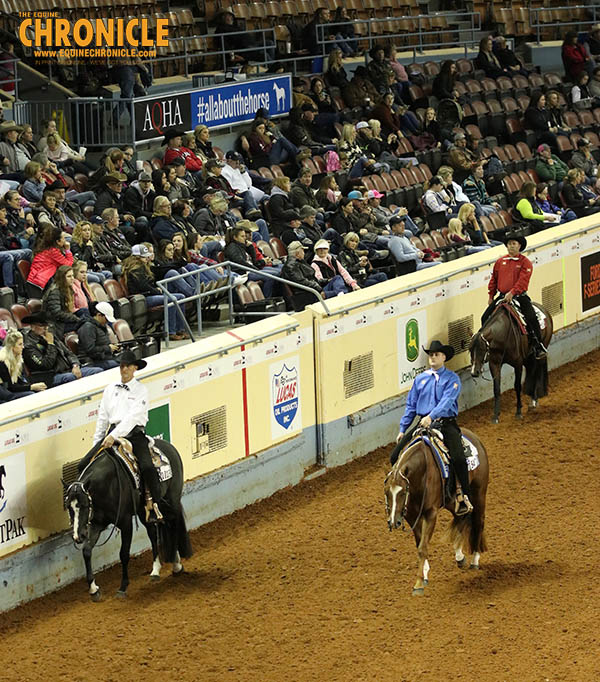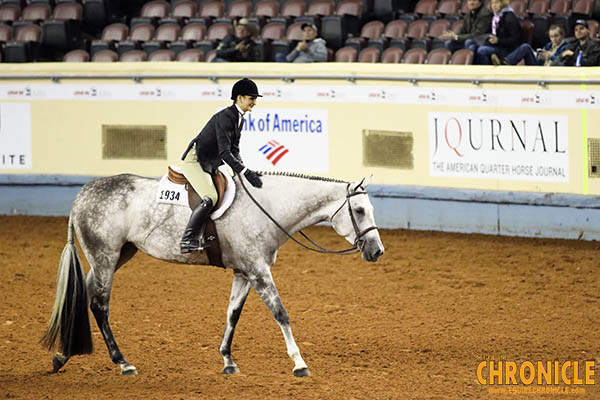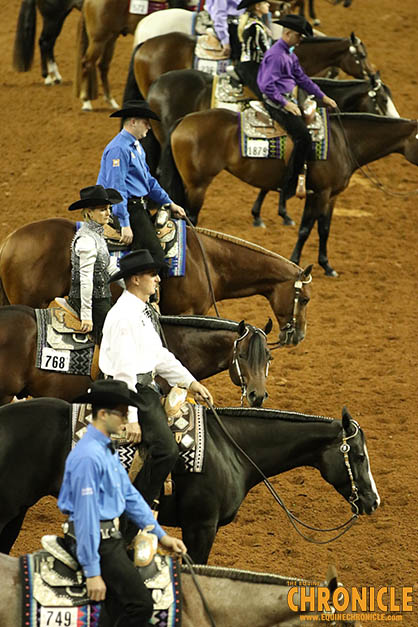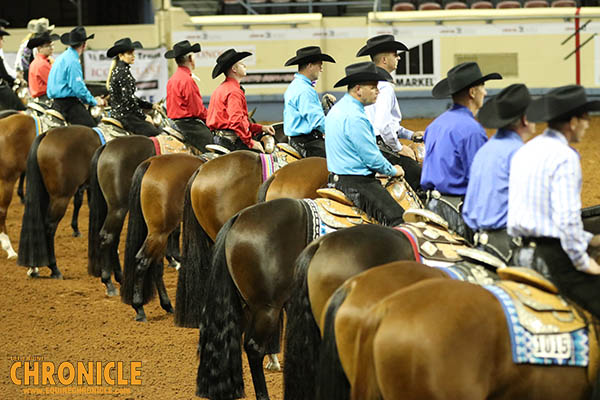New Trend- Splitting L2 and L3 Rail Classes and What That Means For Exhibitors
AQHA’s Leveling program was initially created with the intention of leveling the playing field for exhibitors. By using an objective handicapping system that analyzes points and awards earned, riders and horses are grouped with peers of similar skill levels and accomplishments. The program has been well-received over the past few years with some of the L2 and L1 classes recording the highest number of entries at top horse shows in the country.
Recently, a new trend is making its way to major shows in 2019 where some Open Level 2 and Level 3 rail classes are being run separately. This provides riders with the option of showing one horse in the Level 2 and one horse in the Level 3. Per AQHA rule SHW112, leveled classes that are scored, and pattern classes like Showmanship, Horsemanship, Equitation Over Fences, and Hunt Seat Equitation, must be run concurrently. However, show management reserves the right to split classes that are placed, like Western Pleasure and Hunter Under Saddle.
SHW112. CLASSES. In scored classes which are leveled and in pattern classes, to include showmanship, horsemanship, equitation over fences, and hunt seat equitation, the Level 2 and Level 3 classes must run concurrently. Show management continues to have the option of running any placed classes separately which are leveled. Show management also has the option of running the rookie and Level 1 classes concurrent or separate.
AQHA Manager of Shows Justin Billings shed a little light on the many benefits this arrangement offers. “The option for show management to offer separate rail classes in Level 3 and Level 2 is a real benefit to the Professional Horsemen, their customers, and the shows themselves,” Billings says. “More specifically, it allows a rail trainer to now bring additional horses, much like the Trail, Western Riding, and Ranch Riding trainers have been doing for years. Now, rail trainers have the option to show one horse in Level 2 and another in Level 3, provided the horses meet the eligibility requirements.”
“This helps a customer out too, because their trainer has the opportunity to show more often, creating additional chances for their horse to get shown. It also benefits the show itself by increasing entry numbers and selling extra stalls. We have seen another added benefit for the upcoming trainer by giving them the chance at more exposure and time in the show arena. For these reasons and more, AQHA expects the Level 2 program to continue growing in popularity, even more so with the rail classes.”
 Aaron Moses brought a few extra horses to the Fox Lea Farm Winter Circuit, because he had seen on the schedule that the L2 and L3 Junior Western Pleasure classes would be split. “It’s really an attraction for a horse show, because you can take another horse, or even two horses sometimes,” Moses says. “It can be really hard sometimes picking which horse you’re going to show in a class; but, this way, it gives another customer an opportunity to have his/her horse shown, and it works really well.”
Aaron Moses brought a few extra horses to the Fox Lea Farm Winter Circuit, because he had seen on the schedule that the L2 and L3 Junior Western Pleasure classes would be split. “It’s really an attraction for a horse show, because you can take another horse, or even two horses sometimes,” Moses says. “It can be really hard sometimes picking which horse you’re going to show in a class; but, this way, it gives another customer an opportunity to have his/her horse shown, and it works really well.”
Looking towards future shows in 2019, Moses is planning to compete at the SOQHA Madness, which will be offering this feature.
“It’s really good for participation and gives those trainers with horses, that might not be able to win the Level 3 if all the horses were in there together, the opportunity to do well in Level 2. It’s huge for participation.”
Dawn Baker also took advantage of the opportunity to show two horses in Junior Western Pleasure at the Florida horse show, one in L2 and one in L3. However, she brings up an interesting point regarding how this translates for her when it’s time for the World Show.
“I think it’s a great concept, and it’s wonderful that it provides you with an opportunity to show another horse. However, I believe that Level 2 should be Level 2, no matter what horse show you’re at. I can ride a horse all year long at weekend horse shows and qualify it for Level 2 classes at the World Show (and in fact I did at the Florida shows) but I can’t show it in Level 2 at the World Show. That’s hard to explain to my customer. Whether it’s a weekend horse show or the World Show, I think the rules should be the same. Otherwise, it’s creating sort of a loophole that takes away from what the Level 2 class was originally meant to be.”
Ashley Lakins is another rider who utilized the split to decide whether she wanted to show her horse in Level 2 or Level 3 at the Florida show.
“Level 3 points are so hard to come by these days, even at a weekend horse show. There are just so many good horses, and it’s hard to do. I remember, back in the day, when there were 40 in Junior Western Pleasure at a weekend horse show. These days, I feel like the Green division has taken away from the Junior numbers. As far as the horses go, it’s another good avenue, if they’re allowing a Level 3 rider to show a Level 2 and a Level 3 horse in separate classes. It’s always a benefit to get to show two horses instead of one.”
 “I do think, though, that if you’re going to make the rules at the World Show that only a Level 2 rider can show a Level 2 horse, then that’s probably something they’re going to have to look into making that fit with the rest of the year as well. I think it’s probably not fair for a Level 3 rider to show a horse in a Level 2 class (during the year) if the rider is not allowed to also do it at the World Show.”
“I do think, though, that if you’re going to make the rules at the World Show that only a Level 2 rider can show a Level 2 horse, then that’s probably something they’re going to have to look into making that fit with the rest of the year as well. I think it’s probably not fair for a Level 3 rider to show a horse in a Level 2 class (during the year) if the rider is not allowed to also do it at the World Show.”
Lakins explains the decision she faced when she chose which class to show her client’s horse, VS Code Me Lucky, in during the Florida Winter shows. “On that first day, I wasn’t sure how tough the Level 3 Senior Western Pleasure was going to be, and this is the mare’s first year in the Senior division, so she’s eligible to go in Level 2. We showed in Level 2 and did really well. I was happy to come away with those points.”
”I do think it helps, because those people with Level 2 horses feel like they have a shot at doing better than they would in a Level 3 class that has [World and Congress Champions]. It’s tough to have those horses in there, because your chance of getting any kind of points is hard. If you’re fifth in a class and the top four are all World Champions, that’s great, but it doesn’t help you much for points. A win is a win, regardless of whether it’s in a Level 2 or a Level 3 class, and it certainly sounds better if you were a circuit champion than fifth place.”
 With all this being said, it’s probably a good idea to review a few points about Leveling. First of all, classes are leveled based on exhibitor and horse records. Leveling eligibility is based upon points and awards earned. Youth, amateur, select, Halter, and cattle classes are leveled by exhibitor record. Open classes, with the exception of Halter and cattle, are leveled by horse record.
With all this being said, it’s probably a good idea to review a few points about Leveling. First of all, classes are leveled based on exhibitor and horse records. Leveling eligibility is based upon points and awards earned. Youth, amateur, select, Halter, and cattle classes are leveled by exhibitor record. Open classes, with the exception of Halter and cattle, are leveled by horse record.
However, Level 2 World Show eligibility is a slightly different bag. Since we’re only a few weeks into 2019, we will have to refer on AQHA’s information for 2018 AQHA World Show Level 2 eligibility. Ineligibility for Level 2 classes at the AQHA World Show last year was determined based upon points, alliance partner monies, and AQHA World and Reserve World Championship titles earned.
This was the criteria used to determine ineligibility.
- Points earned in AQHA-approved classes (exhibitors placing in approximately the top 2 percent in horse-based leveled classes will not be eligible as Level 2 competitors); For the 2018 Lucas Oil World, the time period ranges from November 1, 2013 to October 31, 2016, which also coincides with the Leveling program data that determines point ranges for the Leveled class.
- Exhibitors having earned a world or reserve world championship in a specific class by division in the last three years (2015, 2016 and/or 2017). Please note a rule change will go into affect January 1, 2019 which extends the three years to five years (SHW251.6)
- Horses placing in the top two in the Level 3 classes at the Open World Shows are not eligible for Level 2 for the subsequent three years in that class, regardless of points earned in the past three years. Please note a rule change will go into effect January 1, 2019 which extends the three years to five years (SHW251.6)
- Alliance partner guidelines and monies earned by exhibitors and by class. (See specific exclusions by class.) Even though an exhibitor is not expressly listed by name on this list, an exhibitor is not eligible for a level 2 class if that exhibitor meets the criteria named for that particular class.
- Cannot be listed on the ineligible exhibitors list.
For Open exhibitors, earnings from AQHA alliance partners were also considered. For the purpose of this article, we’ve spoken with trainers who primarily compete in Western Pleasure and Hunter Under Saddle, so let’s look at those ineligibility descriptions. For Open Western Pleasure, World and Reserve World Champions, both horses and riders, from the past three years (2015, 2016, and 2017) were ineligible for Level 2 classes. AQHA’s top riders in the top 2% of point earners were ineligible. NSBA’s top 35 Western Pleasure money earners were ineligible, as well as members of NSBA’s Quarter Million Dollar Club. For Open Hunter Under Saddle, the ineligibility followed the same restrictions with the exception of it being NSBA’s top 15 Hunter Under Saddle money earners, instead of the top 35.
Only time will tell how, and if, Level 2 qualifying for the World Show will differ in 2019. As far as the trend of splitting Level 2 and Level 3 rail classes at weekend horse shows is concerned, the Pre-Madness and Madness in Ohio is planning to split the Junior and Senior Hunter Under Saddle and Junior and Senior Western Pleasure into separate Level 2 and Level 3 classes.
More Information About Leveling From AQHA:
Class Level Point Ranges For 2019











